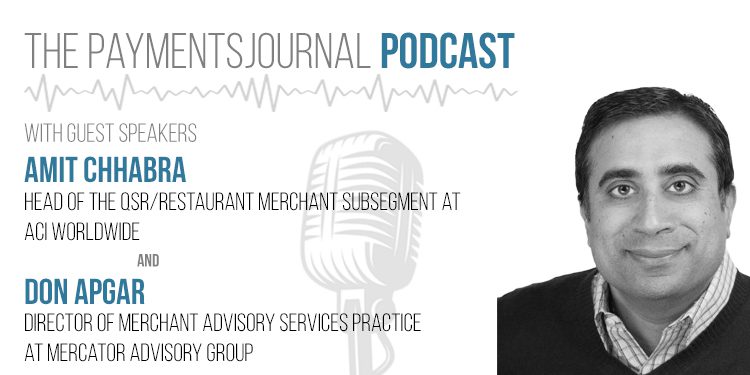Podcast: Play in new window | Download
The fight for consumer mindshare is more competitive than ever. Customers are bombarded with messages in a number of different channels, and standing out among the noise can be difficult for merchants.
The key to doing so is to deliver targeted, relevant promotions and offers in the mobile channel at the right time. To learn exactly how merchants can accomplish this, PaymentsJournal sat with Amit Chhabra, Head of the QSR/Restaurant Merchant Subsegment at ACI Worldwide, and Don Apgar, Director of Merchant Advisory Services Practice at Mercator Advisory Group.
Customers Want To Go Digital
Apgar noted that according to Mercator research, consumers prefer interacting with businesses that they trust in a mobile environment. Digital adoption drastically increased during the COVID-19-related lockdowns of 2020, but that the level of mobile interaction has sustained since then, he added. This means mobile is a vital channel for merchants.
“Being able to connect with a customer where they are at is of tremendous value,” Apgar stated. “Consumers have really become accustomed to interacting in a mobile environment.”
For merchants, this means that using their own native apps in the most optimal way will help them to stand out on a consumer’s crowded smartphone; according to research from Simform, the average user has around 40 apps on their phone.
“It’s important [for merchants] that consumers engage with [the merchants’] mobile app,” said Chhabra. “Many users will delete a mobile app they don’t find value in or don’t use often.”
A New Tool For Mobile Engagement
Chhabra said it was for this reason that ACI launched its Smart Engage mobile engagement platform for merchants in June. Merchants can integrate the platform through their existing mobile application via the Smart Engage software development kit (SDK). He added that the platform is designed to get consumers to interact with a merchant’s mobile app more frequently and create brand awareness.
Merchants can use the platform to send consumers push notifications with specific offers or promotions, and then turn these interactions into sales with one-click in-app purchases. Clicking on the notification consumers receive causes the app to open and “show products the consumer already has some affinity to,” said Chhabra.
“It allows merchants to complement their existing suite of offerings and how they are interacting with consumers,” he added.
For example, merchants can use geolocation to target consumers within a particular area. Or geolocation could be used in conjunction with a print ad that incorporates imagery such as a watermark that, if scanned by the consumer, will have that particular product or offer come up within the merchant mobile app.
“The goal is to target opportunities when the customer has the highest propensity to make a purchase,” said Chhabra. “And then making that purchase very easy for the customer via one-click payments.”
Knowing Is Half The Battle
Mercator research also shows that consumers like being “in the know,” said Apgar, and offering customized products and services via mobile devices is effective because it gives those customers specialized offers that aren’t going out to the general population.
Apgar noted that one area of business where geotargeted mobile offers can be effective is with convenience stores that are attached to gas stations.
“[Fewer] than half of fuel purchasers will go into the convenience store to buy a beverage or a snack,” Apgar added. “This seems like the perfect technology for this sector; you can alert customers there is a coffee special, for example.”
Indeed, Chhabra noted that restaurants and quick-service food stores are the first industries that Smart Engage has been rolled out for, to be shortly followed by retail. The platform is still relatively new, but Chhabra said early returns are good so far.
“Merchants that have added Smart Engage have seen a 40% uplift so far when added to existing promotions,” he added.
The Power of Analytics
Chhabra also said that the platform comes with robust analytics that allow merchants to see the effectiveness of different campaigns and tweak them appropriately. Merchants can adjust or quickly pivot interaction strategies based on real-time data analytics.
“The portal allows the merchant to adjust when notifications go out and under what conditions, and to change the messaging, offer, or coupon associated with the promotion,” he said.
Analytics can also help merchants reduce shopping cart abandonment and optimize the customer experience with real-time data insights. Ultimately, data insights and analytics help merchants improve sales conversion rates by analyzing and identifying patterns through payments data, such as customers’ preferred payment methods, high-performing locations, or performance during different seasons.
Robust data analytics also enable marketing departments to track and identify which programs are working well and which aren’t, and adjust accordingly, Apgar added.
Adding in the capability for one-click checkout is “the holy grail” for merchants, and ACI can help them get there. “Consumers want the interaction on mobile channels to be fast and frictionless,” he concluded. “One-click checkout increases conversion and reduces friction.”
Learn more about ACI and Smart Engage here.
